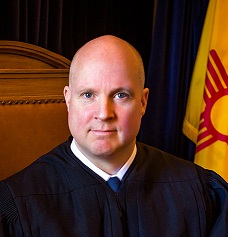New Mexico Supreme Court to hear arguments in Las Cruces, with case serving as part of a civics program for students
Administrative Office of the Courts
SANTA FE – The state Supreme Court resumes a civics education program for students next month when it visits Las Cruces to hear legal arguments in a criminal case.
On April 1, the Court will convene in Las Cruces to hear arguments by attorneys in a case involving three people charged with stealing multiple cattle from their owners in Otero County. High school and college students have been invited to attend the hearing at the Third Judicial District Courthouse. While the justices deliberate after the argument, attorneys for the parties will remain in the courtroom to answer questions from students who attend the hearing. Justices will return to the courtroom to respond to questions from the audience but they will not address the merits of the pending case.

“The Court is excited to announce the second year of the Rule of the Law program,” said Justice David K. Thomson. “The goal is to help young people better understand the role of the court system and the rule of law in our constitutional democracy.”
The visit to Las Cruces marks one of the few times since statehood that the Supreme Court has heard oral arguments outside of Santa Fe. The hearing will be live streamed in English, Spanish and with American Sign Language (ASL) interpretation. The live stream can be viewed from a link on the Court’s website. Any person needing ADA accommodations to attend the April 1 oral argument should email the request to ADA@nmcourts.gov.
The case presents a question about the meaning of the state law prohibiting livestock theft: Whether lawmakers intended each stolen cow to constitute a separate crime or is one crime committed by a defendant stealing multiple cattle at the same time and place.
“The hearing will illustrate for students how courts decide cases by interpreting a law – examining the statutory language and the intent of the Legislature in writing the law – and applying that to the factual circumstances of a particular case,” said Thomson.
On March 31, the justices plan to meet with students at Organ Mountain High School to discuss the judicial process in New Mexico, including how the case set for oral argument reached the Supreme Court. Students from the school are among those to attend the argument. Justices will attend an evening reception on March 31 at New Mexico State University, and speak with students about the rule of law program and careers in the judiciary. Justice Briana Zamora received an undergraduate degree from NMSU.
The Court is hearing a consolidated appeal involving three defendants who have not yet gone to trial. One man – Gerardo Torres – was charged with 18 counts of larceny of livestock for allegedly stealing 18 calves on two occasions from his employer in 2017. Two defendants – Kendale Hendrix and Skeeter Chadwick – were each charged with 25 counts of larceny of livestock for allegedly stealing 25 unbranded cattle from a ranch in 2018.
A district court granted pretrial motions by the defendants to merge the criminal charges: Two counts for Torres — one count for each episode of theft on different days – and one count each for Hendrix and Chadwick for the theft that occurred on a single day. The Court of Appeals upheld the district court decisions. The state appealed to the Supreme Court, arguing that each defendant should face one charge for each head of livestock stolen. The criminal cases against the three defendants remain pending until the appeals are resolved. The consolidated appeal before the Supreme Court is State v. Torres, S-1-SC-38484.
When the Court launched its Rule of Law program last year, Justice Thomson visited classes virtually and spoke with students who watched a recording of an oral argument in a drunken driving case. The program reached nearly 600 students.
This year the Court has added a historical legal component to the program. Justice Thomson is available to visit classes and discuss with students the U.S. Supreme Court’s majority decision and a famous dissenting opinion in Plessy v. Ferguson. The 1896 ruling validated the “separate but equal” doctrine of racial segregation until it was overturned more than a half century later. May 18 marks the 126th anniversary of the Plessy decision and the dissent by Justice John Harlan, who wrote that constitutional protections were color-blind and “all citizens are equal before the law.”
Educators who want their students to participate in the Court’s Rule of Law program during April and early May should contact Justice Thomson’s chambers, 505-827-4932. Schools can select whether the program will focus on the Torres case or the Plessy decision. Learning materials in Spanish and English are available for educators on both programs. The recorded argument in the Torres case will be available for students to watch in English, Spanish and with ASL interpretation. There also is a short video about Plessy v. Ferguson.
###
Contact: Barry Massey, public information officer
Email: bmassey@nmcourts.gov
Phone: 505-470-3436